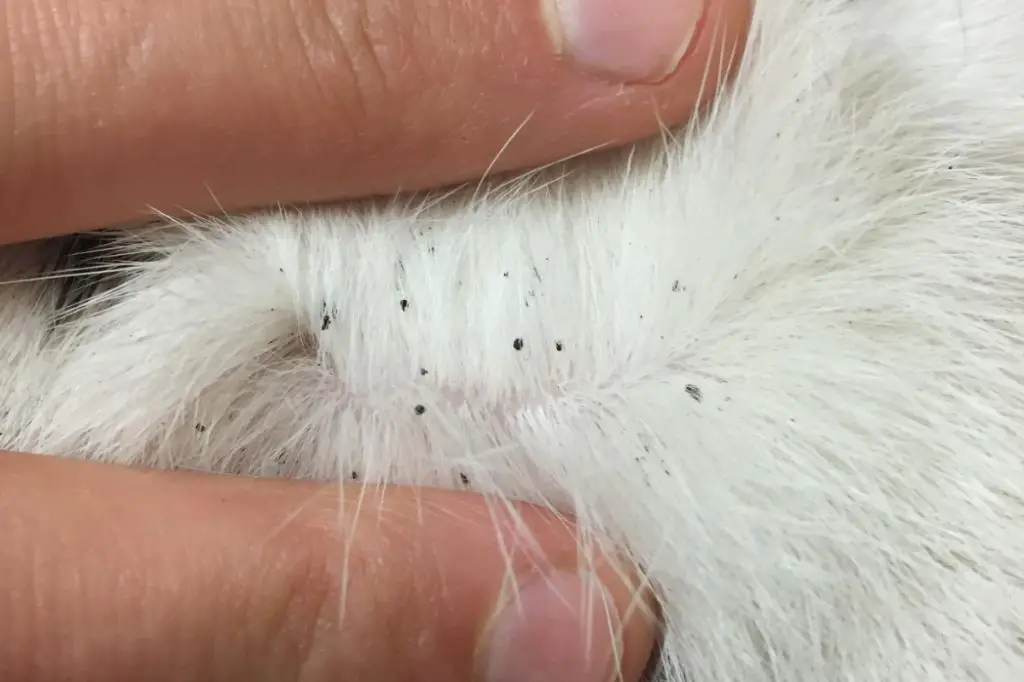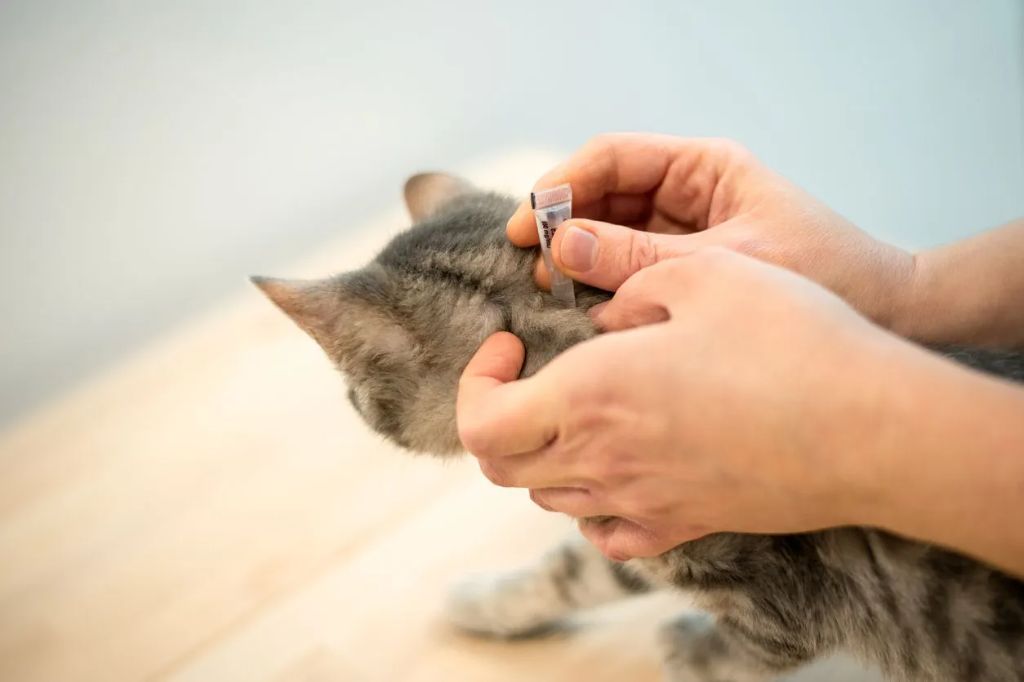Cat fleas (Ctenocephalides felis) are small parasitic insects that can infest both cats and dogs. They are the most common external parasite found on pets, with studies showing prevalence between 10-40% (Abdullah 2019). Cat fleas feed on blood and can cause irritation, discomfort, and transmission of diseases. This article will provide an overview of the physical characteristics, life cycle, feeding habits, reproduction, preferred habitats, signs of infestation, diseases, treatment, and prevention methods for cat fleas.
Physical Description
Cat fleas are tiny in size, measuring about 1/8 inch (around 3mm) in length as adults. They have flattened, oval-shaped bodies that allow them to move smoothly through an animal’s fur or human hair. Their bodies are a reddish-brown to blackish color, helping them camouflage amongst their hosts’ coats.[1]

These fleas have narrow heads and their hind legs are adapted for jumping, making them adept at latching onto and moving between hosts. Their legs end in claws that enable them to cling tightly to fur and skin. They are laterally compressed, meaning their bodies are flattened side-to-side, an anatomical adaptation that enhances their ability to navigate through fur and hair shafts.[2]
Under a microscope, the flea body segments, legs, flattened shape, and mouthparts used for feeding are clearly visible. The adults have no wings, in contrast to some other types of fleas.
In summary, the common cat flea is a tiny, flattened, wingless insect with strong hind legs for jumping. Their dark coloration provides camouflage on animal hosts. Their anatomy equips them to thrive among the fur and hair of pets and people.
Life Cycle
The life cycle of cat fleas consists of four distinct stages: egg, larva, pupa, and adult. Adult female fleas lay eggs on the cat which fall off into the environment. Eggs hatch into larvae within 2-12 days. The larvae feed on organic debris and adult flea excrement for 5-11 days before spinning a cocoon and entering the pupal stage. Pupae can remain dormant for weeks to months, only emerging when triggered by the presence of a host. Once emerged, the adult flea will jump onto the cat to feed within seconds (1,2).
The entire life cycle from egg to adult flea can range from 2 weeks to 8 months, depending on environmental conditions. Warmer temperatures and higher humidity allow the flea life cycle to progress more quickly. The average is around 3-6 weeks in a home. Adult fleas can live 2-3 months and females may lay up to 50 eggs per day, allowing populations to grow rapidly given the right conditions (1,2).
Understanding the flea life cycle is key for effective treatment and prevention. Breaking the life cycle requires treating both the cat and home environment thoroughly and repeatedly to eliminate eggs, larvae, pupae, and adults. Vigilance is needed as just a few surviving adult fleas can replenish the infestation (2).
(1) https://www.rentokil.com/id/en/services/pest-control-services/fleas/cat-flea-life-cycle
(2) https://www.palehorsepestcontrol.uk/cat-fleas-life-cycle
Feeding Habits

Cat fleas feed on warm-blooded animals, primarily cats and dogs. The fleas use their mouths to pierce the skin and suck blood from the animal host. According to the Flea Science website, fleas are classified as sedentary parasites, meaning their bodies remain motionless on the skin while they insert their mouthparts to feed.
Cat fleas prefer to feed on cats, kittens, and even humans. The fleas bite the skin and suck blood from just below the surface. They ingest 15 to 20 times their weight in blood daily. The fleas remain on the host animal continually feeding until fully engorged, then detach and fall off. Cat fleas can survive 1 to 2 months between feedings, but they need access to host blood in order to reproduce.
Flea bites on cats and kittens often appear around the head, neck, and base of the tail. The bites look like small red spots with a brighter red center where the flea penetrated the skin. Flea dirt, composed of digested blood, is sometimes visible in the cat’s fur near the bite. Heavy infestations in kittens can cause life-threatening anemia from blood loss.
Reproduction
Cat fleas reproduce at an extremely rapid rate. According to Hartz, female cat fleas start producing eggs within 24 to 48 hours after taking their first blood meal and can lay up to 50 eggs per day under optimal conditions (Hartz). The University of Florida notes that female cat fleas lay eggs at a rate of up to one egg per hour, which translates to 24 eggs per day (UF). With this incredible rate of reproduction, a single female flea can produce hundreds to thousands of eggs over her lifetime.
The eggs readily fall off the cat into the environment, leading to rapid infestation if not controlled. According to Elanco, one flea can lay 50 eggs per day that fall off the cat as it moves around the home and outdoors (Elanco). Within days, a home can have thousands of flea eggs dispersed and developing into adults. This is why it’s critical to control fleas quickly on cats before they can reproduce out of control.
Preferred Habitats
Fleas prefer to live on cats in areas with relatively little hair and close to the skin, as this allows them easier access to feed on the cat’s blood. Some of the most common areas fleas inhabit on a cat’s body include:
https://be.chewy.com/signs-your-cat-has-fleas/
The neck – The neck has very fine hairs and is a prime spot for fleas to bite and feed. Check around the neck near the base of the head for signs of fleas.
Lower back – The area above the tail also has thinner hair growth, making it another hotspot. Flea dirt may be visible when combing through the fur on the lower back.
Base of the tail – The base of the tail and surrounding area often lacks hair, giving fleas a perfect place to attach themselves. Look for flea dirt in this region.
Back of the hind legs – The thighs and legs have thinner fur, and fleas can hide in these areas. Check the fur at the back of the legs and look for small insects or flea dirt.
In summary, the areas with the least hair like the neck, tail base, and hind legs offer fleas the best access to cat skin for feeding. Thoroughly inspecting the cat’s fur in these regions can reveal signs of flea habitation.
Signs of Infestation
Cat fleas are extremely irritating for cats. When a cat has a flea infestation, there are some clear signs to look out for. According to https://www.innovativepest.com/6-ways-how-to-tell-if-your-cat-has-fleas/, the most common signs of a flea infestation in cats include:

- Excessive scratching and biting – Fleas cause severe itchiness, so cats will scratch, bite and lick themselves constantly in an attempt to relieve the irritation.
- Bald patches and hot spots – Frequent scratching and biting can lead to hair loss and skin injuries.
- Scabs and red skin – Constant scratching can cause scabs to form and make the skin red and irritated.
- Flea dirt – Small dark specks of flea excrement can be found on the cat’s skin and coat.
- Irritability and restlessness – The discomfort of fleas can make cats act agitated.
According to https://www.newhopeanimalhospital.org/site/blog/2020/08/10/fleas-everything-cats-dogs, flea allergy dermatitis is also common in cats with fleas. This can lead to severe itching, hair loss, scabs, and skin infections. Catching and treating a flea infestation early is important to relieve discomfort and prevent skin problems in cats.
Diseases
Cat fleas can transmit a variety of diseases to pets and humans, but one of the most concerning is bartonellosis. Bartonellosis is caused by bacteria in the genus Bartonella, with Bartonella henselae being the most common species infecting cats and humans. Cat fleas are the main vector for transmitting Bartonella henselae, the bacteria that causes cat scratch disease in humans.
When an infected cat is bitten by a cat flea, the flea ingests the bacteria along with the blood. The bacteria then multiplies inside the flea’s gut. When the infected flea bites another cat or human, it defecates as it feeds and the infected feces can enter the bite wound or a scratch. From there, the bacteria spreads through the lymph nodes and bloodstream, causing systemic infection.
In humans, cat scratch disease from bartonellosis typically causes lymph node swelling, fever, fatigue, and muscle pain. More severe symptoms like encephalitis, endocarditis, and damage to the liver, spleen, and eyes can also occur. While cat scratch disease is usually self-limiting, antibiotics are sometimes prescribed for compromised patients. There is currently no vaccine available. Controlling fleas on pets is crucial for preventing transmission.
Treatment
Getting rid of a cat flea infestation requires treating both the animal and the home environment. There are several effective treatment options to kill adult fleas and their eggs on cats. Topical spot-on medications like Frontline, Advantage II, and Revolution are applied to the skin on the back of the neck and spread over the body via skin oils. They are very effective at killing adult fleas and eggs, providing month-long protection with a single application (Source). Oral treatments such as NexGard, Bravecto, and Capstar can also quickly kill adult fleas within hours. For heavy infestations, flea combs can help remove some of the mature fleas and eggs. It’s critical to treat the home as well by vacuuming thoroughly and using sprays, powders, or foggers with insect growth regulators according to the product instructions.

Prevention
Preventing flea infestations requires diligence and consistency. Here are some tips for keeping your cat flea-free:
Vacuum often – vacuum at least once a day, especially in areas your cat frequents like furniture and rugs. Vacuuming picks up eggs and larvae and reduces the risk of reinfestation. Empty the vacuum contents in a sealed bag afterwards.
Groom regularly – use a flea comb to groom your cat daily. This helps remove larvae and adults on your cat’s skin before they can reproduce. Dispose of any fleas caught in a soapy water solution.
Wash bedding – wash your cat’s bedding at least once a week in hot water to kill any flea eggs or larvae present. This includes bedding areas like cat condos, scratching posts and pet beds.
Treat your home – use sprays and foggers containing insect growth regulators in your home. This stops flea eggs and larvae from maturing into adults. Be sure to follow all label instructions.
Monitor closely – check your cat’s skin often for any signs of fleas like “flea dirt.” Catching an infestation early allows for quicker treatment.
Consider preventives – talk to your vet about monthly spot-on or oral preventives that kill fleas and eggs. These medications stop infestations before they start.
Work with your vet – if fleas persist, consult a vet for safe and effective products to eliminate the infestation. They can recommend a treatment plan suited for your home and cat.
With diligence and vet-recommended products, it’s possible to prevent cat fleas from invading your home and pets. Consistency is key – adhering to a thorough prevention regimen helps stop infestations before they start.
